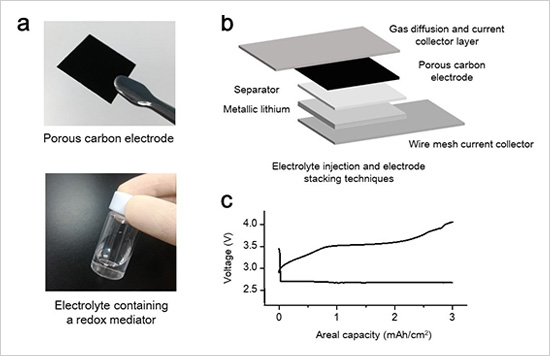Development of a Lithium-Air Battery with an Energy Density over 500 Wh/kg
—One of the World’s Highest Energy Densities Achieved—
2021.12.15
National Institute for Materials Science (NIMS)
Japan Science and Technology Agency (JST)
SoftBank Corp.
NIMS and SoftBank Corp. have developed a lithium-air battery with an energy density over 500Wh/kg—significantly higher than currently lithium ion batteries. The research team then confirmed that this battery can be charged and discharged at room temperature.
Abstract
- NIMS and SoftBank Corp. have developed a lithium-air battery with an energy density over 500Wh/kg—significantly higher than currently lithium ion batteries. The research team then confirmed that this battery can be charged and discharged at room temperature. In addition, the team found that the battery developed by the team shows the highest energy densities and best cycle life performances ever achieved. These results signify a major step toward the practical use of lithium-air batteries.
- Lithium-air batteries have the potential to be the ultimate rechargeable batteries: they are lightweight and high capacity, with theoretical energy densities several times that of currently available lithium ion batteries. Because of these potential advantages, they may find use in a wide range of technologies, such as drones, electric vehicles and household electricity storage systems. NIMS has been carrying out basic research on lithium-air batteries with support from the ALCA-SPRING program (ALCA: Advanced Low Carbon Technology Research and Development Program, SPRING: Specially Promoted Research for Innovative Next Generation Batteries). This program has been funded by the Japan Science and Technology Agency (JST) with the goal of accelerating large-capacity rechargeable battery R&D. In 2018, NIMS and SoftBank co-founded the Advanced Technologies Development Center to conduct research with the goal of putting lithium-air batteries into practical use in mobile phone base stations, the Internet of Things (IoT), HAPS (high altitude platform stations) and other technologies. Despite their very high theoretical energy densities, only a small number of lithium-air batteries with high energy densities have actually been fabricated and evaluated. This limited success is attributed to the fact that a large proportion by weight of lithium-air battery contains heavy inactive components (e.g., separators and electrolytes) that do not directly participate in actual battery reactions.
- This research team had previously developed original battery materials that significantly increase the performance of lithium-air batteries in ALCA-SPRING-supported research. The team then developed a technique to fabricate high-energy-density lithium-air cells at the NIMS-SoftBank Advanced Technologies Development Center. Finally, the team created a new lithium-air battery by combining these new materials and the fabrication techniques. The developed battery exhibited the energy density over 500 Wh/kg—substantially higher than currently lithium ion batteries. Notably, the repeated discharge and charge reaction proceeds at room temperature. The energy density and cycle life performance of this battery are among the highest ever achieved.*
* Based on surveys conducted by NIMS (as of December 14, 2021) - The team is currently developing higher-performance battery materials and plans to integrate them into the newly developed lithium-air battery with the aim of greatly increasing the battery’s cycle life. The team then plans to expedite efforts to put the battery into practical use at the NIMS-SoftBank Advanced Technologies Development Center.
- This project was carried out by a research team led by Shoichi Matsuda (Senior Researcher, NIMS), Manai Ono (Postdoctoral Researcher, NIMS), Shoji Yamaguchi (Specialist Staff, NIMS) and Kohei Uosaki (Research Fellow, NIMS; also Director, NIMS-SoftBank Advanced Technologies Development Center).
- This work was mainly supported by the JST ALCA-SPRING program and the NIMS-SoftBank Advanced Technologies Development Center.
- This research was published in the online version of Materials Horizons at 2:00 am on December 15, 2021, Japan Time.

Figure. (a) New materials for lithium-air batteries developed by ALCA-SPRING project. (b) Cell fabrication technique developed by the NIMS-SoftBank Advanced Technologies Development Center. (c) Demonstration of stable discharge/charge cycles of lithium-air batteries with energy density over 500Wh/kg operated at the room-temperature.
Related files
- Center for Green Research on Energy and Environmental Materials (GREEN)
Contact information
(Regarding this research)
-
Shoichi Matsuda
Senior Researcher
Rechargeable Battery Materials Group,
Center for Green Research on Energy and Environmental Materials
National Institute for Materials Science
Tel: +81-29-860-4637
E-Mail: MATSUDA.Shoichi=nims.go.jp
(Please change "=" to "@")
(Regarding JST programs)
-
Shinichi Kato
Department of R&D for Future Creation
Japan Science and Technology Agency
K's Gobancho, 7, Gobancho, Chiyoda-ku, Tokyo 102-0076, Japan
Tel: +81-3-3512-3543
E-Mail: alca=jst.go.jp
(Please change "=" to "@")
(General information)
-
Public Relations Office
National Institute for Materials Science
Tel: +81-29-859-2026
Fax: +81-29-859-2017
E-Mail: pressrelease=ml.nims.go.jp
(Please change "=" to "@") -
Public Relations Division
Japan Science and Technology Agency
5-3, Yonbancho, Chiyoda-ku, Tokyo 102-8666, Japan
Tel: +81-3-5214-8404
Fax: +81-3-5214-8432
E-Mail: jstkoho=jst.go.jp
(Please change "=" to "@")
Same Keywords
-
Identification of a Major Factor Influencing the Cycle Life of Practical Li-O2 Batteries
(lithium-air battery,battery,energy density)
2020.12.02
-
Development of Ultra-High Capacity Lithium-Air Batteries Using CNT Sheet Air Electrodes
(lithium,battery)
2017.04.05
-
Development of 1-Wh-Class Stacked Lithium-Air Cells
(lithium)
2025.09.19
Recent Press Release
-
Simultaneous Imaging of Intracellular DNA and RNA Using Harmless Light
2025.10.27
-
Development of an AI Device Using Ion Gel and Graphene That Dramatically Streamlines Machine Learning Computations
2025.10.14
-
Demonstrating a Novel Method to Modulate Heat Flow Through the Collective Motion of Spins
2025.10.06
